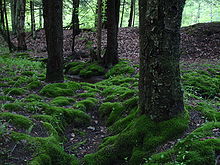The custom of employing the flowering branches for decorative purposes on 1 May is of very early origin, but since the adoption of the Gregorian calendar in 1752, the tree has rarely been in full bloom in England before the second week of that month. In the Scottish Highlands, the flowers may be seen as late as the middle of June. The hawthorn has been regarded as the emblem of hope, and its branches are stated to have been carried by the ancient Greeks in wedding processions, and to have been used by them to deck the altar of Hymenaios. The supposition that the tree was the source of Jesus's crown of thorns doubtless gave rise around 1911 to the tradition among the French peasantry that it utters groans and cries on Good Friday, and probably also to the old popular superstition in Great Britain and Ireland that ill luck attended the uprooting of hawthorns. Branches of Glastonbury thorn (C. monogyna 'Biflora',[7] sometimes called C. oxyacantha var. praecox), which flowers both in December and in spring, were formerly highly valued in England, on account of the legend that the tree was originally the staff of Joseph of Arimathea.
Robert Graves, in his book The White Goddess, traces and reinterprets many European legends in which the whitethorn (hawthorn), also called the May-tree, is central.
In Celtic lore, the hawthorn plant was used commonly for inscriptions along with yew and apple. It was once said to heal the broken heart. In Ireland, the red fruit is, or was, called the Johnny MacGorey or Magory.
Serbian and Croatian folklore notes hawthorn (Serbian глог, Croatian glog) is particularly deadly to vampires, and stakes used for their slaying must be made from the wood of the thorn tree.
In Gaelic folklore, hawthorn (in Scottish Gaelic, sgitheach and in Irish, sceach) 'marks the entrance to the otherworld' and is strongly associated with the fairies. Lore has it that it is very unlucky to cut the tree at any time other than when it is in bloom; however, during this time, it is commonly cut and decorated as a May bush (see Beltane). This warning persists to modern times; it has been questioned by folklorist Bob Curran whether the ill luck of the De Lorean Motor Company was associated with the destruction of a fairy thorn to make way for a production facility.
Hawthorn trees are often found beside clootie wells; at these types of holy wells, they are sometimes known as rag trees, for the strips of cloth which are tied to them as part of healing rituals. 'When all fruit fails, welcome haws' was once a common expression in Ireland.
According to a Medieval legend, the Glastonbury thorn, C. monogyna 'Biflora', which flowers twice annually, was supposed to have miraculouslygrown from a walking stick planted by Joseph of Arimathea at Glastonbury in Somerset, England. The original tree was destroyed in the 16th century during the English Reformation, but several cultivars have survived. Since the reign of King James I, it has been a Christmas custom to send a sprig of Glastonbury thorn flowers to the Sovereign, which is used to decorate the royal family's dinner table.










